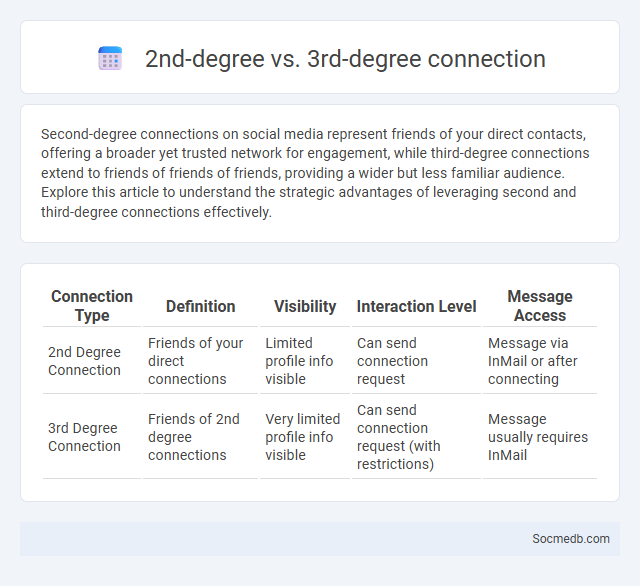
Photo illustration: 2nd degree vs 3rd degree connection
Second-degree connections on social media represent friends of your direct contacts, offering a broader yet trusted network for engagement, while third-degree connections extend to friends of friends of friends, providing a wider but less familiar audience. Explore this article to understand the strategic advantages of leveraging second and third-degree connections effectively.
Table of Comparison
| Connection Type | Definition | Visibility | Interaction Level | Message Access |
|---|---|---|---|---|
| 2nd Degree Connection | Friends of your direct connections | Limited profile info visible | Can send connection request | Message via InMail or after connecting |
| 3rd Degree Connection | Friends of 2nd degree connections | Very limited profile info visible | Can send connection request (with restrictions) | Message usually requires InMail |
Understanding LinkedIn Connections: An Overview
LinkedIn connections represent professional relationships that facilitate networking, job opportunities, and industry insights. Understanding the difference between 1st, 2nd, and 3rd-degree connections enhances targeted communication and expands reach effectively. Leveraging LinkedIn's connection algorithms and engagement features boosts profile visibility and strengthens professional influence.
What Is a 1st Degree Connection?
A 1st degree connection on social media refers to a direct link between you and another user, meaning you have mutually accepted each other's connection requests. This immediate connection allows you to communicate directly, share content, and view each other's profile information without restrictions. Having a strong network of 1st degree connections enhances your visibility and opportunities across platforms like LinkedIn or Facebook.
Defining 2nd Degree Connections
Second-degree connections on social media are individuals connected to your direct network but not directly linked to you. These connections often expand your professional reach by providing access to new contacts through mutual friends or colleagues. Understanding and leveraging your second-degree connections can unlock valuable networking opportunities and enhance your online presence.
Exploring 3rd Degree Connections
Exploring 3rd degree connections on social media platforms expands networking opportunities by reaching friends of friends of friends, increasing visibility beyond immediate networks. Leveraging algorithms that identify overlapping interests and mutual contacts enhances meaningful interactions with individuals in these extended circles. Tools like LinkedIn's advanced search and Facebook's suggested friends facilitate targeted engagement with 3rd degree connections to grow professional and social networks strategically.
Key Differences: 2nd vs 3rd Degree Connections
Second-degree connections on social media are users connected through a mutual friend, enabling indirect interaction and expanded networking opportunities. Third-degree connections extend further, connecting users through two intermediaries, often resulting in weaker social ties and reduced trust. Understanding these degrees influences engagement strategies, targeting, and relationship-building effectiveness on platforms like LinkedIn and Facebook.
The Importance of 1st, 2nd, and 3rd Degree Connections
First-degree connections on social media represent direct relationships, enabling immediate communication and stronger trust for networking or collaboration. Second-degree connections expand reach by linking to friends of friends, facilitating introductions and increasing opportunities for growth or partnership. Third-degree connections broaden visibility further, allowing users to access wider networks and discover unexpected connections that can enhance professional or social influence.
Networking Strategies for Each Connection Type
Effective networking strategies vary based on social media connection types such as acquaintances, industry peers, and close contacts. Tailor your engagement by sharing relevant content and personalized messages for acquaintances, participating in professional groups and discussions with industry peers, and maintaining regular, meaningful interactions to strengthen close contacts. Your ability to adapt communication styles and provide value across these networks enhances relationship building and career growth opportunities.
Leveraging Your LinkedIn Network for Opportunities
Leveraging your LinkedIn network effectively enhances career growth by connecting with industry leaders and participating in relevant professional groups. Optimizing your profile with targeted keywords and regularly sharing insightful content increases visibility and attracts recruiters. Engaging consistently with connections through personalized messages and endorsements fosters trust and opens doors to new job opportunities and collaborations.
Privacy and Accessibility: Connection Degree Impacts
Social media platforms increasingly balance user privacy with accessibility, where connection degree directly influences the visibility of shared content and personal data exposure. First-degree connections typically access more detailed personal information, whereas wider network tiers receive limited or anonymized data to mitigate privacy risks. Enhanced privacy controls and customizable accessibility settings empower users to manage their digital footprint and safeguard sensitive information within their social connections.
Maximizing Value from All Levels of Connections
Leveraging your social media presence involves engaging meaningfully with connections across all levels--from close friends to acquaintances and industry contacts. Tailoring content to resonate with diverse audiences enhances trust and fosters authentic interactions. Your strategic approach to nurturing these varied relationships maximizes opportunities for networking, collaboration, and personal growth.
 socmedb.com
socmedb.com